


The Forsyte Chronicles
Series · 18
books · 1900-1978
Books in series
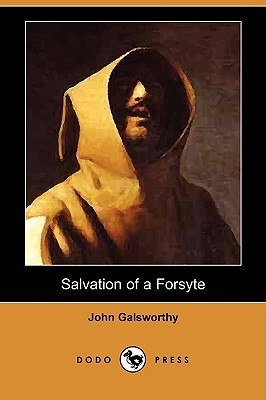
#0.5
Salvation of a Forsyte
1900
In 'Salvation of a Forsyte' by John Galsworthy, the reader is transported back to early 20th century England to witness the intricate dynamics of the Forsyte family. Galsworthy's prose is rich in detail and character development, offering a poignant exploration of societal values and individual desires. The novel delves into themes of love, morality, and reputation, showcasing the complexities of human relationships and the tensions between tradition and modernity. Galsworthy's keen observations and subtle nuances make 'Salvation of a Forsyte' a compelling read that resonates with readers of all ages. His writing style is both elegant and evocative, capturing the essence of the time period with grace and depth. The book serves as a valuable literary work that not only entertains but also enlightens its audience on the human condition and the societal norms of the era. 'Salvation of a Forsyte' is a classic novel that continues to captivate readers with its timeless themes and enduring relevance.

#1
The Man of Property
1906
The most prized item in Soames Forsyte's collection of beautiful things is his wife, the enigmatic Irene. But when she falls in love with Bosinney, a penniless architect who utterly rejects the Forsyte values, their affair touches off a series of events which can only end in disgrace and disaster.
John Galsworthy tackles his theme of the demise of the upper-middle classes with irony and compassion.

#1.5
Indian Summer of a Forsyte
1918
In a short interlude after The Man of Property, Galsworthy delves into the newfound friendship between Irene and Old Jolyon Forsyte (June's grandfather, and by now the owner of the house Soames had built). This attachment gives Old Jolyon pleasure, but exhausts his strength. He leaves Irene money in his will with Young Jolyon, his son, as trustee. In the end Old Jolyon dies under an ancient oak tree in the garden of the Robin Hill house.

#2
In Chancery
1920
The three novels which make up The Forsyte Saga chronicle the ebbing social power of the commercial upper-middle class Forsyte family between 1886 and 1920. Galsworthy's masterly narrative examines not only their fortunes but also the wider developments within society, particularly the changing position of women. This is the only critical edition of the work available, with Notes that explain contemporary artistic and literary allusions and define the slang of the time.
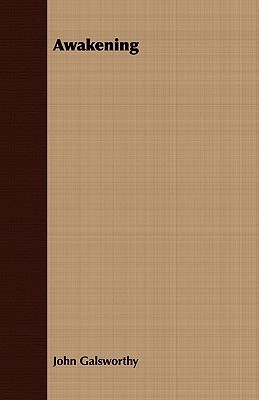
#2.5
Awakening
1920
This work has been selected by scholars as being culturally important, and is part of the knowledge base of civilization as we know it. This work was reproduced from the original artifact, and remains as true to the original work as possible. Therefore, you will see the original copyright references, library stamps (as most of these works have been housed in our most important libraries around the world), and other notations in the work. This work is in the public domain in the United States of America, and possibly other nations. Within the United States, you may freely copy and distribute this work, as no entity (individual or corporate) has a copyright on the body of the work.As a reproduction of a historical artifact, this work may contain missing or blurred pages, poor pictures, errant marks, etc. Scholars believe, and we concur, that this work is important enough to be preserved, reproduced, and made generally available to the public. We appreciate your support of the preservation process, and thank you for being an important part of keeping this knowledge alive and relevant.

#3
To Let
1921
To Let, the final volume of the Forsyte trilogy, chronicles the continuing feuds of the two factions within the troubled Forsyte family. The shadow of the past returns to haunt the lives of a new generation, as Irene's son Jon falls in love with Soames' daughter Fleur with tragic consequences.

#4
The White Monkey
1924
FOURTH IN THE FORSYTE CHRONICLES FOLLOWING THE FORSYTE FAMILY FROM THE 1886 THROUGH THE 1920'S.

#5
The Silver Spoon
1926
Fleur and Michael Mont entertain the glittering society characters of the day in their new, elegant, and fashionable house. As always, Fleur’s father—Soames Forsyte—is constantly by the side of his daughter, spoiling and watching over her. But London after the war is a place of carefree attitudes that are alarming and baffling to old Soames. Just when he thinks he is protecting his daughter, he finds himself triggering a major social scandal.

#6
Swan Song
1928
The nine novels which make up The Forsyte Chronicles—one of the most popular and enduring works of 20th century literature—chronicle the ebbing social power of the commercial upper-middle class Forsyte family between 1886 and 1920. Galsworthy's masterly narrative examines not only their fortunes but also the wider developments within society, particularly the changing position of women. The author has drawn a fascinating and accurately detailed picture of the British propertied class. Often incorrectly called The Forsyte Saga - the nine novel sequence properly known as The Forstye Chronicles contains three trilogies- of which the first trilogy is The Forsyte Saga (The Man of Property - In Chancery- To Let). The second trilogy- A Modern Comedy (The White Monkey- The Silver Spoon- Swan Song) is followed by the third and concluding trilogy- End of the Chapter (Maid in Waiting- Flowering Wilderness- One More River).
Michael Mont is succeeding in his public life in Parliament, but holds grave doubts about his private life and his wife, Fleur. Fleur's original love, Jon Forsyte, her cousin and the son of her father's ex-wife, returns to England where a meeting is inevitable. Fleur's undying love for Jon is disclosed. Other members of the Forsyte family are included in this eminently readable saga.

#6.5
On Forsyte 'Change
1930
In 1930 Galsworthy published On Forsyte 'Change which deals in the main with the older Forsytes before the events chronicled in The Man of Property. Galsworthy states in a foreword that "They have all been written since Swan Song was finished but in place they come between the Saga and the Comedy…" By way of explanation he says that "It is hard to part suddenly and finally from those with whom one has lived so long; and these footnotes do really, I think, help to fill in and round out the chronicles of the Forsyte family".
Contents:
The Buckles of Superior Dosset, 1821-1863
Sands of Time, 1821-1863
Hester's Little Tour, 1845
Timothy's Narrow Squeak, 1851
Aunt Juley's Courtship, 1855
Nicholas Rex, 1864
A Sad Affair, 1867
Revolt at Roger's, 1870
June's First Lame Duck, 1876
Dog at Timothy's, 1878
Midsummer Madness, 1880
The Hondekoeter, 1880
Cry of Peacock, 1883
Francie's Fourpenny Foreigner, 1888
Four-In-Hand Forsyte, 1890
The Sorrows of Tweetyman, 1895
The Dromios, 1900
A Forsyte Encounters the People, 1917
Soames and the Flag, 1914-1918

#7
Maid In Waiting
1931
John Galsworthy (1867-1933) devoted virtually his entire professional career to creating a fictional but entirely representative family of propertied Victorians, the Forsytes. He made their lives and times, loves and losses, fortunes and deaths so real that readers accused him of including as characters in his drama real individuals whom they knew.Often incorrectly called THE FORSYTE SAGA, the nine novel sequence properly known as THE FORSYTE CHRONICLES contains three trilogies, of which the first trilogy is THE FORSYTE SAGA (THE MAN OF PROPERTY, IN CHANCERY, TO LET). The second trilogy, A MODERN COMEDY (THE WHITE MONKEY, THE SILVER SPOON, SWAN SONG) is followed by the third and concluding trilogy, END OF THE CHAPTER (MAID IN WAITING, FLOWERING WILDERNESS, ONE MORE RIVER). THE FORSYTE CHRONICLES has become established as one of the most popular and enduring works of twentieth century literature, described by the New York Times as: "A social satire of epic proportions and one that does not suffer by comparison with Thackeray's VANITY FAIR...the whole comedy of manners, convincing both in its fidelity to life and as a work of art."

#8
Flowering Wilderness
1932
The nine novels which make up The Forsyte Chronicles - one of the most popular and enduring works of 20th century literature - chronicle the ebbing social power of the commercial upper-middle class Forsyte family between 1886 and 1920. Galsworthy's masterly narrative examines not only their fortunes but also the wider developments within society, particularly the changing position of women. The author has drawn a fascinating and accurately detailed picture of the British propertied class Often incorrectly called The Forsyte Saga - the nine novel sequence properly known as The Forstye Chronicles contains three trilogies- of which the first trilogy is The Forsyte Saga (The Man of Property - In Chancery- To Let). The second trilogy- A Modern Comedy (The White Monkey- The Silver Spoon- Swan Song) is followed by the third and concluding trilogy- End of the Chapter (Maid in Waiting- Flowering Wilderness- One More River). John Galsworthy (1867-1933) devoted virtually his entire professional career to creating a fictional but entirely representative family of propertied Victorians- the Forsytes. He made their lives and times- loves and losses- fortunes and deaths so real that readers accused him of including as characters in his drama real individuals whom they knew. He was the winner of the Nobel Prize for Literature in 1932.

#9
One More River
1933
Clare Charwell has just fled her sadistic husband to England. Along the way she has met the charming Tony Croom. When she refuses to return to her husband, he falsely accuses her of adultery with Tony in a highly public court trial.
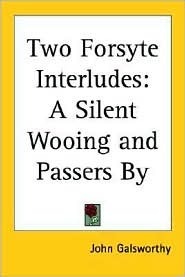
#11
Two Forsyte Interludes
A Silent Wooing; Passers by
1928
1928\. English novelist and playwright, winner of the Nobel Prize for Literature in 1932, Galsworthy became known for his portrayal of the British upper middle class and for his social satire. He is most famous for The Forsyte Saga, which consists of a sequence of three novels and these two interludes. See other titles by this author available from Kessinger Publishing.
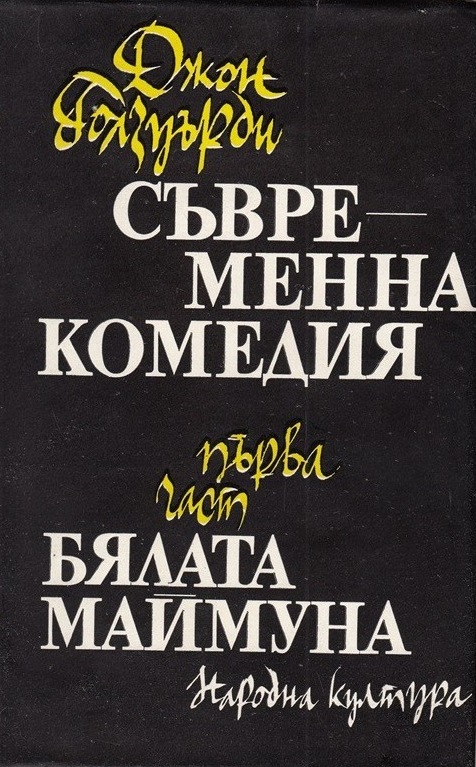
#23
Бялата маймуна. Съвременна комедия, Първа част
1978
Съдържа и интерлюдията Мълчаливо ухажване
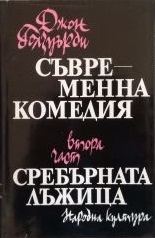
#24
Сребърната лъжица. Съвременна комедия, Втора част
1978
Съдържа и интерлюдията Минувачи

#25
Forsytes, Pendyces and Others
1935
#7-9
Pēdējā lappuse
1931
In this final volume of The Forsyte Saga Galsworthy writes about the lives and loves of the Cherrell family, cousins of the Forsytes. For centuries, the Cherrell sons have left their home of Condaford Grange to serve the state as soldiers, clergymen and administrators, but the 1930s bring uncertainty in a world of rapidly altering morals and unemployment. Galsworthy's portrayal of the effect of political change on individuals show him as a great social novelist as well as the author of one of the most gripping family sagas ever written.
Authors

John Galsworthy
Author · 58 books
Literary career of English novelist and playwright John Galsworthy, who used John Sinjohn as a pseudonym, spanned the Victorian, Edwardian and Georgian eras. In addition to his prolific literary status, Galsworthy was also a renowned social activist. He was an outspoken advocate for the women's suffrage movement, prison reform and animal rights. Galsworthy was the president of PEN, an organization that sought to promote international cooperation through literature. John Galsworthy was awarded the Nobel Prize in literature in 1932 "for his distinguished art of narration which takes its highest form in The Forsyte Saga."